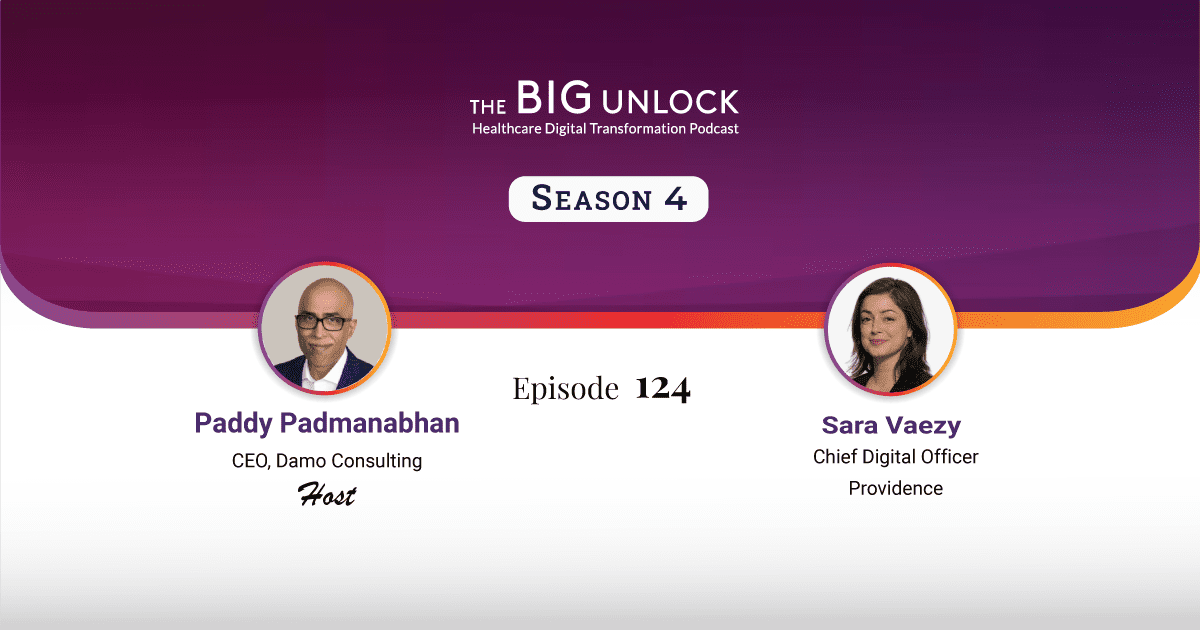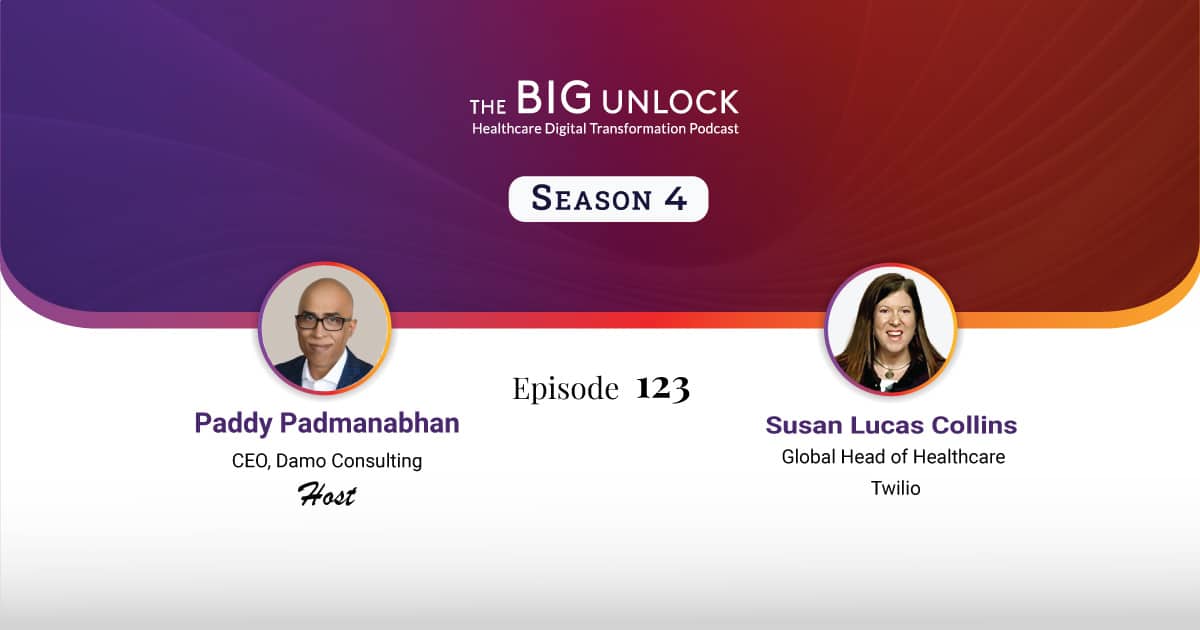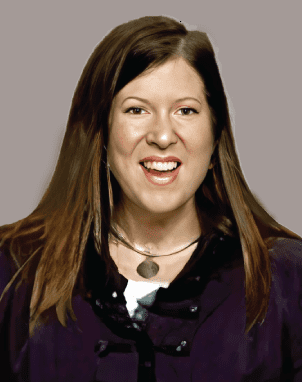Podcast with Sara Vaezy, Chief Digital Officer, Providence
"We are building a consumer identity and engagement platform as the cornerstone of our digital strategy"
 Hosted by Paddy Padmanabhan
Hosted by Paddy Padmanabhan 
Share
In this episode, Sara Vaezy, Chief Digital Officer of Providence talks about her new priorities, the increased focus on patient acquisition through marketing and patient engagement tools, and the role of identity-based marketing programs that get tied with the returns on investment. Sara also discusses the digital health innovation ecosystem, the startup funding environment, and all the tough choices that health systems make in the context of an economic slowdown.
Sara talks about unlocking new business models and operationalizing digital in a multi-modal context to solve both consumer and health system problems that go beyond substituting a physical visit for a virtual visit. She also states that health systems are now going through a much-needed re-evaluation of the value generated by digital business models and partnerships. Take a listen.
Show Notes |
||||
| 00:41 | About your new role and immediate priorities. | |||
| 05:18 | Why do you think health systems today are choosing to define the digital function in product management terms? | |||
| 07:41 | Can you describe some of the trends you're seeing in healthcare today? | |||
| 12:44 | Compared to other industries, healthcare is certainly catching up. But historical factors determine how quickly you can transform the siloed nature of data – medical information, demographics, social profiles, and privacy concerns. What makes healthcare a little more challenging? | |||
| 18:22 | With the hybrid care delivery model, patients receive some care at home and clinics too. How much of this have you implemented at Providence and how do you ensure a seamless experience? | |||
| 22:48 | There are plenty of digital health startups with thousands of good solutions, smart people, and some VC money. But the change in the funding environment could mean trouble for a few of them. What are your thoughts on this? | |||
| 28:05 | What do you see as a macro-outlook for the next 12 months? What kind of scenarios are you playing out in the context of digital health investments or even your own innovation programs? | |||
About our guest

Sara Vaezy is the Chief Digital Officer for Providence where she is responsible for digital strategy, product innovation, marketing, digital experience, and commercialization for the integrated delivery network (IDN) which includes 52 hospitals and 1,085 clinics and serves over 5 million unique patients.
Sara is the architect of the Providence digital innovation model upon with the Digital Innovation Group (DIG) was founded, resulting in company partnerships and incubation of technologies that deliver value for Providence as well as other health system. The model has resulted in the commercialization of three incubated technologies into independent companies from within DIG— all of which are supporting Providence in delivering on its mission and vision of health for a better world.

Sara Vaezy is the Chief Digital Officer for Providence where she is responsible for digital strategy, product innovation, marketing, digital experience, and commercialization for the integrated delivery network (IDN) which includes 52 hospitals and 1,085 clinics and serves over 5 million unique patients.
Sara is the architect of the Providence digital innovation model upon with the Digital Innovation Group (DIG) was founded, resulting in company partnerships and incubation of technologies that deliver value for Providence as well as other health system. The model has resulted in the commercialization of three incubated technologies into independent companies from within DIG— all of which are supporting Providence in delivering on its mission and vision of health for a better world.
Sara is active in the broader healthcare industry serving as an NCQA Board Director, as a member of inaugural class of the Frist Cressey Ventures Collective, a Health Evolution Forum Fellow, World 50 Digital 50 member, and a Forbes Business Council Member. She has won numerous awards and has been recognized as a Business Insider 30 under 40 Transforming the Future of Healthcare (2019), Catholic Health Association Tomorrow’s Leader (2019), a Becker’s Rising Star in Health IT (2020), and a Becker’s Women to Watch in Health IT (2020 & 2022).
She holds an MHA and an MPH in Health Policy from the University of Washington School of Public Health and BAs in Physics and Philosophy from the University of California, Berkeley.
Q. Sara, tell us a little about your new role and your immediate priorities.
Sara: My role actually has three parts. The first, that of a Chief Digital Officer, is a bit of a misnomer because the first big part of the organization is the marketing and digital experience. This isn’t just digital marketing or just marketing of digital products but all organizational marketing and really like customer-facing, top-of-the-funnel customer acquisition all the way through in terms of getting our users to convert and acquire services from us. So, the organizational marketing and digital experience spans our marketing platforms, analytics, regional strategy, planning around marketing, website search, performance marketing, and our e-commerce activities both, on our own digital properties as well as on partner properties. Take for instance our payer partners and how we syndicate content and appointments and things like that to them. That constitutes the first big part.
The second part is product development. We have a product development shop with about 80 people that are building enterprise software primarily for health systems. Our core thesis is in terms of where they’re pointed at. We build customer-facing platforms that do not exist in the market today, and we build what we think are essential in terms of health systems having a role in driving the development of those platforms.
The third piece is, once we build, we commercialize. The last part of that is strategy that concerns not just where we build and what goes to our product development team but also spans taking these solutions to market, spinning them out into new companies and then, doing quite a bit of actual market development. In many cases then, we’re building platforms that don’t exist or which are new categories. We just need to educate the broader market out there as to what it is, why it’s important, and what we’re doing among other things.
To your question around priorities, we’ve done all sorts of things in the past — looked at a pretty broad scope of customers, studied consumer-facing solutions, whether they were more growth, mar-tech types of solutions, or even looked at access and convenience things that are behavioral health. We’ve also done work in health equity and in the last six months and in particular, this past quarter, we’ve really doubled down on just focusing all our efforts on driving the growth value proposition and the growth imperative for the organization.
In most industries, and I’m not talking about modernizing infrastructure here, but about digital transformation from a customer-facing perspective. The primary place where digital has a real role is in generating demand, aggregating demand, and capturing demand. That’s what we’re doing. We’re driving growth for the system through customer acquisition, customer retention through engagement, and capturing LTV. We’re changing the LTV equation for our health system and since it’s difficult to do, we’re focusing on that for we want growth, profitable growth all day, every day.
Q. Why do you think health systems are choosing to define the digital function in product management terms, today?
Sara: There are a lot of different answers to this. But here’s one which is that infrastructure and enablement only go so far. You really have to think about the problem that you’re solving for your user all up; in fact, the whole end-to-end experience. That’s what product managers do. They think about the entire problem and start from the customer backwards, hopefully. So, that’s one thing.
The other piece is in healthcare. I’d say that in any other industry, digital unlocks new business models. You must take that product management approach to ensure this else, you’re just enabling the same kind of core business. We have a lot of that, too, in healthcare.
However, unlocking the new business models or operationalizing digital in the context of new forms of access, for instance, is something we’ll get to in a little bit, but multi-modal care is not just about substituting a physical visit for a virtual visit. There’s a lot more to it than that if you really want to solve both, the consumer and the health system’s problems. That’s why it’s becoming increasingly prevalent. You need to think beyond infrastructure and really start thinking about new business models, new customer use cases, and that more transformative aspect of it.
Q. How are your patients and your target audiences driving some of your thinking? Can you describe some of the trends you’re seeing that may be of interest to our listeners?
Sara: There are a lot of different things that have especially happened or accelerated over the course of the last couple of years given both, COVID and greater familiarity with technology, in the context of our healthcare. I’ll just talk about a couple.
The first, is what I just mentioned earlier, multimodal. It’s just the notion of patients and users getting comfortable with both, the physical and the virtual and how these exist in a hybrid environment, together. But there are expectations that go along with this, for instance, the continuity of your data or your authenticated state as a given individual, and an identity that goes along with you as opposed to just these one-off transactional things that may or may not persist across the different mechanisms by which you encounter a system. This concept of “hybrid” is something we’ve seen over the last couple of years and read quite a bit about but, I think, there’s going to be increasingly more of that in different patient segments and use cases. I don’t anticipate that trend to go away.
Another piece of that is that’s tangentially related to the concept of identity. Identity-driven engagement and personalization drives engagement. What I mean by that is if you take the classic example of Pinterest, or any e-commerce platform, say, your home page on Amazon.com. That is going to look very different from my home page there because we are different people with different purchasing patterns, plus we live in different parts of the country. So, based on everything that Amazon knows about us, they are able to drive a completely different personalized experience for you versus for me. That is coming to health care. That’s coming in the context of how specific transactions may or may not be relevant to you. It may be a virtual one or a physical one, but it’ll become relevant to the context of outbound marketing. For instance, we’ve got good at being able to recognize, through some of our marketing platforms’ work, who is in the market for a specific service with us. That helps us undertake targeted outreach. So, we can say to them, “We’ve noticed that you’ve been engaging with us around content for knee pain or you’re being searching for orthopedic surgeons. How can we help you?” That there is personalized targeted marketing, outreach, and outbound marketing.
The third area is just around this as it relates to personalization. It’s just about engagement experiences, in general, that encompass knowing who you are and being persistent. There is a single place for all your information and it’s not just health system-centric, it’s marketplace-centric. We are building, for instance, what we call a consumer identity and engagement platform based on this general trend.
Identity is the cornerstone. It knows that I am who I am. It undertakes identity resolution, management, and identity verification, and then that identity powers a profile of me as an individual and in a single access channel, personalizes my transactions, my billing experiences, my third-party apps, and the services that are relevant to me. This happens on an ongoing basis, not just around an episode of care, but like between episodes of care. We’ve talked about this in healthcare for some time but as we solve the identity and the data problems, it begins to actually become real.
Q. While industries such as, ecommerce, personal banking, securities, travel, and hospitality are further ahead, healthcare is certainly catching up. However, some historical factors determine how quickly you can transform the siloed nature of data – medical information, demographics, social profiles and privacy concerns — related to this. Tell us, what makes healthcare difficult and maybe just a little more challenging?
Sara: Stitching together the data at an individual level and not just clinical data, is one of the key challenges. However, you must solve the problems around data before addressing the fragmentation problem. Stitching that together is difficult because all of the data elements exist in different places.
That example of marketing outreach that I gave earlier, required our team to stitch together Epic and web traffic data. So, it’s not just clinical stuff. It’s all about — how are they performing on our online properties? What are people searching for? How are they navigating their way around financial data? We can purchase data from other sources, integrate them, and then, layer on top of not just the data itself. It’s the models that actually tell you — Is this person in market or out of market for specific services? Stitching together the data or even getting the data out of these different siloes can be very difficult.
Our infrastructure is no secret. Healthcare, for example, is relatively antiquated in terms of the core infrastructure that it has, so, that’s a big problem. You mentioned security so I’ll say, we have an incredible cybersecurity team with folk from across the industry, ecommerce, and other places that have done this kind of work in the past. We’re very fortunate that we’re ahead but in many cases, that is a big barrier especially where security issues can actually hamper the ability to make progress around these kinds of things.
Second, it’s not just the fragmentation on the technology side of things but how it translates into the operationalized channels where care is delivered. That’s still a challenge for us especially nowadays with the worsening workforce crisis and increased burden on caregivers. It’s tough to actually operationalize some of these things in the context of where care is delivered.
However, that is not really a digital problem to solve though some exceptions remain. For instance, we are working on a decision support, similar to a customer service or self-service use case for something that we’re building and calling a conversational and navigation platform which is in one place. It surfaces up as our chat bot. In some places, the chat bot can be focused on all sorts of different problems – something complex as symptom-checking the differential diagnoses or even something very basic like resetting my password and administrative use cases.
What we’re working on is the inbox management problem for our caregivers. Out there, you can tackle it across different pain points. There’s a lot of work being dedicated to this once a message is generated. From triaging it and having different roles on a carrier team tackle different problems or different types of messages, what we’re working on is way upstream of that.
That begs the question, why are those messages being generated in the first place? How can we provide our customers, our users with tools and content to prevent those messages or some proportion of them, from being generated in the first place? There are ways to tackle that sort of in-person experience or even the stuff that gets generated around a specific encounter as well. But there’s a tremendous amount of data that’s required in order to be able to do that. So then, we get to come full-circle to the data problem.
Q. Let’s talk about care delivery. With the hybrid model, patients receive some care at home and then, come into the clinic, too. The communication process then, becomes critical so you don’t need to ask them for the same things, repeatedly. There may be an analogy in Retail – BOPIS (Buy Online Pay In-Store). How much of this was at Providence? How much of this have you implemented? How do you ensure a seamless experience? Have you had any successes that our audience could learn from?
Sara: We’re only at the very beginning stages of this journey but I’ll say that identity is the cornerstone here. You have to have identity that transcends beyond the clinical system of records, because not all of this sits within it. If you’re ceding your identity to just the EMR, then, that’s the first challenge that needs to be overcome. There’s that piece.
We built a simple patient identity platform which has over 4 million accounts now and it resolves all these for us in terms of pulling the identity out and doing everything we talked about. It also undertakes identity federation to third parties and services outside the system of record. That’s one very core element in terms of being able to do this more broadly. I think that’s key. That’s the first key.
The second is, starting to then think about how customers across both, the physical and the virtual actually go through a funnel and convert into buying a service. We, through a combination of our product development as well as our digital experience teams, incubated a technology called DexCare, which we spun out last year. That does three things with identity at its root. They’ve got their own SSL platform, which is around that whole demand aggregation piece. This ensures that your services are discoverable by users. Those services could be physical or virtual but you don’t want to artificially silo them and put people down one specific path without giving them the options that are most relevant to them. Equally important is navigating folk to what is most appropriate based on their intent, motivation, clinical appropriateness, and how the delivery system is structured, operationally.
The third piece matches the supply to the demand. This becomes very interesting in a hybrid environment because there, it’s either available or not. There are different types of services and when you start going into virtual modalities, these could be synchronous or asynchronous videos or chat-based, so, the complexity really increases from there.
So, we work with identity first to understand who the user is, to enable navigation to the options that are relevant to them, and then, to convert them to buy into a service by matching supply to demand. That’s another way by which we’ve actually operationalized it.
I’ve seen really tremendous results. Around 30% of the patients that come through our digitally enabled channel are new to the system, while around 80% of them are commercially insured and stay with us. We have relationships with them and that generates downstream revenue for us as well, so, it’s not just a one-off.
Q. Let’s talk about technology enablement. There are plenty of digital health startups with thousands of good solutions, smart people and some VC money. But, the change in the funding environment could mean trouble for a few of them. You’ve harnessed innovation from the marketplace, so what are your thoughts on what’s going on?
Sara: It’s definitely going to mean trouble for some and potentially, many. We’ve gone through an exciting but relatively undisciplined period and now that the financial tides are turning, we are going to have to become disciplined out of necessity.
The financial state and financial health of buyers and that of the health systems is not good right now. So, as we think about solutions to engage with getting value for those solutions, demonstrated value — demonstrated ROI and not vague, fancy hand-waving and lots of unjustifiable multiples — is going to be absolutely top priority. It’s all going to be about demonstrating value. So, we’re doing quite a bit of work to enhance what we do. We have operational metrics, for instance, that we’re on the hook for, but we’re getting crisper about our returns on digital investment as a system. That will be the number one change — Can you actually return something to the buyers in the form of some sort of demonstrated value?
The other thing is, often, in these types of environments and this happened in multiple cycles — the Great Recession, in 2008-09, or even during the dotcom boom — cash is always king. Hopefully, cash is a proxy for value and it’s presumably if you have cash, that you will probably have something good to sell to the market. I hope that that’s the case and that ultimately with this calling that happens, we’ll end up with solutions that are really meaningfully moving the needle for us.
Q. Cash is king, and it’s even better if the cash is internally accrued through a business as opposed to investor funding. But, how long can you make it stretch? Have you had to make difficult decisions with your portfolio of startups?
Sara: In our system, we are actively going through those discussions right now. I suspect every single health system in the country is going through that, too. Even for our internally-led efforts, we’re actually thinking — Do we really need to do this or not? Is this that important? Is it that foundational? The answer, generally speaking, is yes.
That’s because we’ve done the homework to say that this platform does not exist and so, it’s important enough from a differentiation perspective that we absolutely need to build it. However, we’re going to have to keep coming back to that. It’s like coming back to that and ensuring that our efforts are well-aligned and well-coordinated across the system. We are just in a position where we have to be extremely good stewards of our resources and any “messing around” is just unforgivable at this point.
Q. Does this mean that there’s a “flight towards safety”? Will you approach your EHR areas or your enterprise class technology vendors with deep pockets to ride out any cycle because they’ve got all this cash that they’re sitting on?
Sara: There’s always that. Now it continues to be a theme. That’s why we’re just going back to first principles and really saying it where it’s only absolutely essential. The definition of “absolutely essential” may change. But it’s not a foregone conclusion that these things are absolutely essential at this stage. Depending on how performance improves over the coming quarters, that definition may change and we’re prepared for that.
Q. What do you see as a macro-outlook for the next 12 months? What kind of scenarios are you playing out in the context of digital health investments, continued investment in digital health strategy programs or digital health start-ups, or even your own innovation programs?
Sara: Similar to what we’re seeing in the venture-backed market, it will be all on focus. I suspect that the focus is going to be on a lot of dabbling in digital health and tech-enabled services. There’s a lot of dabbling going on everywhere.
I also think those days are over so, everyone is going to be forced to get more disciplined. The expectations, I think, are going to increase around the value that’s generated by new business models or digital models. So, there will be a lot of innovation efforts going away because they’ll be more “nice to have” than “essential” or maybe because they just aren’t able to articulate their value prop. They may have been extremely valuable but they may not have been able to communicate it or quantify it.
It is not to say I’m pessimistic, but I think, this will be a really tough time. Health systems are going through a turning point and it’s a much needed turning point. In how we do our business, how we serve our customers, and how we’re structured to do so, we’re all going to get leaner and meaner. That’s good; good for affordability and from a macro-perspective. It’s good but it’s just going to be a tough time. We will live to fight another day.
We hope you enjoyed this podcast. Subscribe to our podcast series at www.thebigunlock.com and write to us at [email protected]
Disclaimer: This Q&A has been derived from the podcast transcript and has been edited for readability and clarity.
Recent Episodes
About the host
Paddy is the co-author of Healthcare Digital Transformation – How Consumerism, Technology and Pandemic are Accelerating the Future (Taylor & Francis, Aug 2020), along with Edward W. Marx. Paddy is also the author of the best-selling book The Big Unlock – Harnessing Data and Growing Digital Health Businesses in a Value-based Care Era (Archway Publishing, 2017). He is the host of the highly subscribed The Big Unlock podcast on digital transformation in healthcare featuring C-level executives from the healthcare and technology sectors. He is widely published and has a by-lined column in CIO Magazine and other respected industry publications.





